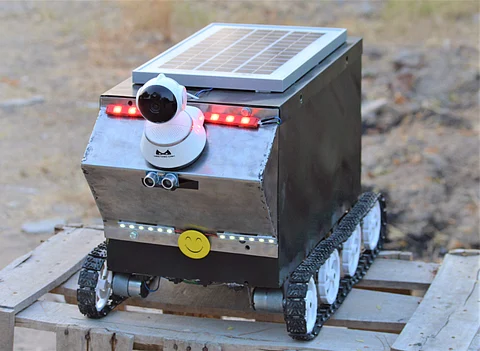

According to the GlobalFirepower website, the total number of military personnel in India is 34,62,500 (approx). Though the newspapers constantly give us updates about attacks in war zones and other parts of the country, we barely get to know more about the injured soldiers. In order to show their respect and support for these brave soldiers who bravely protect the country from the front-lines, a group of students from Sri Ramakrishna Engineering College, Coimbatore made an Automatic Soldier Rescue Rover. Explaining their invention, one of the students, Surya M says, "Our professor encouraged us to come up with a product that would be useful for military purposes. Taking this as a challenge, we initially thought of creating a bot that was capable of attacking. But we came to know that such an invention already exists. So, taking medical needs into consideration and making it a priority, we started working on this rescue rover."
The rescue rover resembles a war tanker and is equipped with navigation, obstacle avoidance, land mine identification and 360-degree surveillance systems. The navigation is powered by fuel used in tankers, whereas the equipment inside the rover is powered by solar energy. "Inside the rover, there is a stretcher, camera surveillance, human health monitoring system and injury analysis system," says S Jeevanantham, Assistant Professor, Electronics and Instrumentation Engineering Department, Sri Ramakrishna Engineering College. Explaining its working, he shares, "Every soldier in the base station is given a wrist band which is enabled with GPS and an alert button. If the soldier is injured, he can press the alert button which will alert the rover. The rover, which is in the base station, then navigates with the help of GPS and reaches the spot. On reaching, the back door of the rover opens up and a stretcher comes out. The soldier can lie on the stretcher which is then pulled back in by the rover. The Artificial Intelligence bot inside the rover, which has a health monitoring system, continuously monitors the soldier's condition and can also provide the essential first aid. It also locates injuries on the soldier's body. The doctors at the base station can monitor the soldier through the camera present in the rover and prepare to receive him for further treatment, thus saving his life."
So, what happens when it is a critical injury and the soldier is unable to press the emergency button? "If a soldier's heartbeat or pulse rate changes, the rover will get an alert. Hence, when the rover reaches the war field where the soldier is injured and sees no response from him, an immediate alert is passed to a nearby soldier. In case there is no sign of help, the bot inside the rover helps pull the soldier on to the stretcher," adds the professor. The rover can rescue only one person at a time, so if there are many injured, then it can be used as a transporting device. Simply put, the rover can bring one soldier at a time to the nearest safe zone and the doctors can then treat the soldiers. By implementing this idea, further loss of human resources can be prevented.
The team, which includes Surya M, Logesh MK and Tharaneedharan K headed by their professor S Jeevanantham, successfully tested their small prototype after working on it for almost a year and a half. "Since it was our very first attempt, we had to go by a trial-and-error method. There were days when we started working on it as early as 6 in the morning and kept at it till late in the night," says Surya, who is currently pursuing his third year in Electronics and Instrumentation Engineering.
Talking about the safety of the rover, Jeevanantham says, "The rover is bulletproof. There is a 360-degree camera on the outside and a camera inside as well. So, placing any foreign body inside is not possible technically as it is continuously under surveillance." With an initial investment of about `60,000 funded by their college for the prototype, the team has applied for a patent for their invention and are proposing to bring this product out in real-time. They have presented the product at the India International Science Festival which happened in Kolkata recently. They have also applied to the India Innovation Contest conducted by the Department of Science and Technology and were appreciated for their innovative idea.
